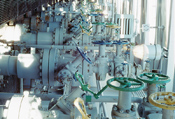
|
|
Different automated equipment options

Over the lifetime of manufacturing, owners and managers have searched to find the most productive ways to manufacture and distribute their products while ensuring quality and quick turnaround. Since the invention of computers, a revolution in automated equipment has come into the manufacturing world and offered new and more effective ways of building solid and sellable pieces.
|
|
There are many types of automated equipment ranging from industrial robots, assembly systems, test equipment, vision systems, and safety equipment such as light curtains.Industries that rely heavily on machinery such as automotive and appliance industries use automated machines to make their production more reliable and efficient.Computer controlled equipment can run continuously with no or very little margin of error.Whereas there will always be human error, these systems can be programmed to run the same complex routines on a continuous basis with little assistance from their human counterparts. The automated systems will keep your human error ratio lower and this will make customers happier as well since they will not worry about product defects and other concerns.
Robotic systems have revolutionized our industrial world.Automated systems include pick and place units that specialize in assembly, packaging and tooling work. These processes can be incredibly sophisticated and easily become more time proficient and reliable than human hands.Many of these automated robotic systems run on compressed air, helping factories adhere to their strict energy efficiency standards.
Additional robotic equipment handles dispensing glue, liquid and even food materials. Anything from welding, assembly, packaging and inspection processes can be automated by various complex machines. There are Self Compliant Assembly Robot Arms (SCARA) that perform detailed small part assembly functions and are e programmable to the specifications needed in each area.These arms offer flexibility with up to six axes, making them much faster than a two-armed human who is working to palletize or place specific items in storage.
Assembly lines have increased their ability to run more efficiently and with better quality through the use of automated equipment.Automated systems are in place for assembling, cleaning and inspecting products at high speeds. This time of equipment may be used to assemble intricate circuit boards, medical devices, and pharmaceuticals. Touch screen interfaces allows human operators to program and operate the system separately. Internal arms, spindles and cameras, all robotic and automated, perform all the work with a press of the button and the inspection capabilities of these systems can detect microscopic flaws in detailed and small products.
Automated test equipment can produce applications for integrated circuit analysis, defect analysis and testing of PCB operations.Joint Test Action Group (JTAG) boundary scan testers provide all these automated analysis.Optical inspection and x-ray inspection allows inspectors to use automated equipment to see hidden components such as solder joints that may otherwise be unrecognizable with the bare human eye.
Automated equipment systems are not limited to assembly and inspection of metals and plastics. These systems are used every day in food manufacturing and security.A light curtain, which is a light beam with sensors, offers specialized security within high speed manufacturing machines.These curtains protect operators by shutting power down to the machines in an instant if the light is blocked, effectively reducing the chance of serious injury or breakage in the machinery.
Automated equipment has definitely become commonplace in most manufacturing facilities. It was brought about in the early 1900's and it has continued to grow and make significant strides. From cars, toys, computers, to food, almost everything we use these days has been touched by an automated robotic system that produced a more consistent and flawless product.
Privacy Policy, Terms of Use